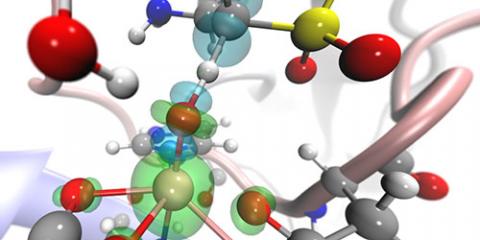
The biochemical turnover of taurin is catalysed by taurine dioxygenase, aided by molecular oxygen and alpha-ketogluterate. The rate-limiting step is a hydrogen atom transfer for which a significant kinetic isotope effect was found experimentally. To study it with high predictive power, quantum mechanics is needed for the chemical transformations at the catalytic centre, but the protein environment also needs to be taken into account. Since a full quantum description is computationally infeasible, a QM/MM approach was used.
“ChemShell was invaluable for this project as it took over the coupling of the quantum mechanics program and the force field, as well as the geometry optimisations and rate calculations”, says Sonia Álvarez-Barcia from the University of Stuttgart, Germany, who conducted the study. The simulations found that atom tunnelling increases the efficiency of the enzyme by a factor of 40 and explains the strong kinetic isotope effect.
S. Álvarez-Barcia and J. Kästner, “Atom Tunneling in the Hydroxylation Process of Taurine/α-Ketoglutarate Dioxygenase Identified by Quantum Mechanics/Molecular Mechanics Simulations.” J. Phys. Chem. B, 2017, 121, 5347–5354.
